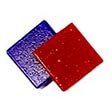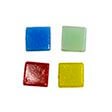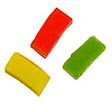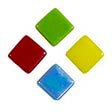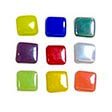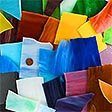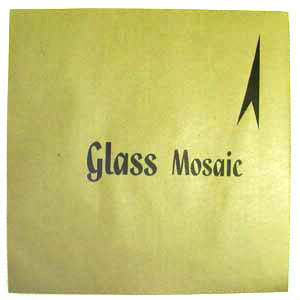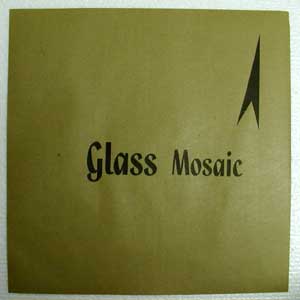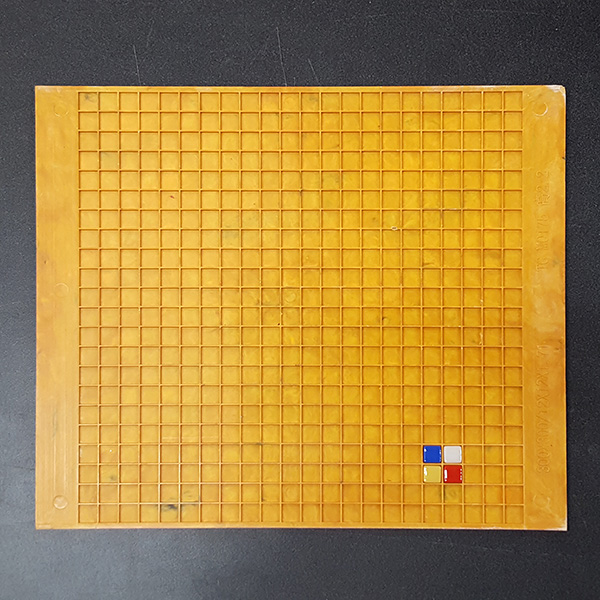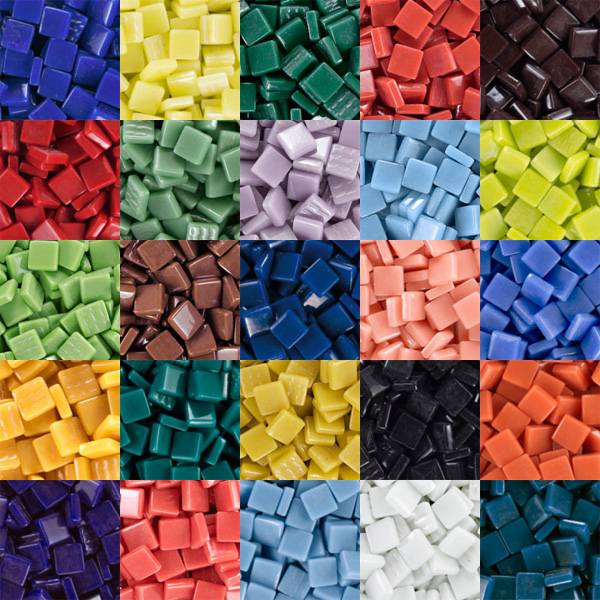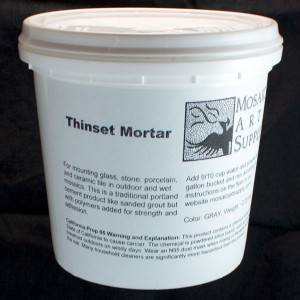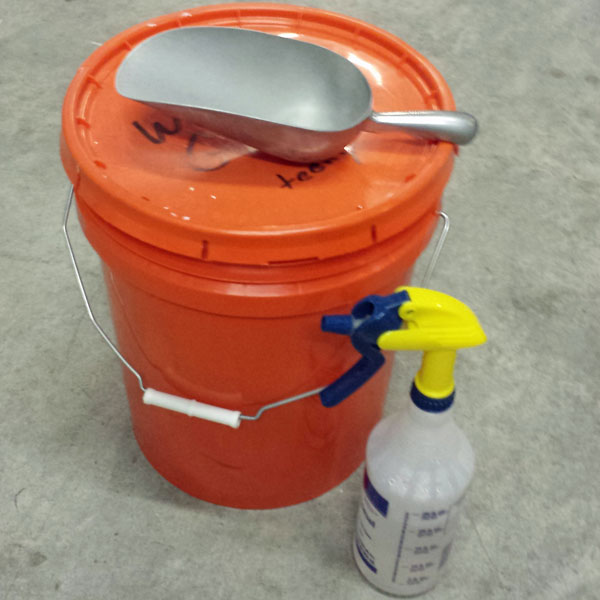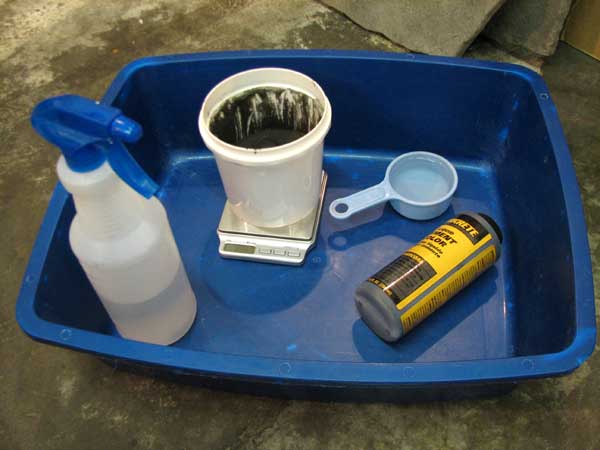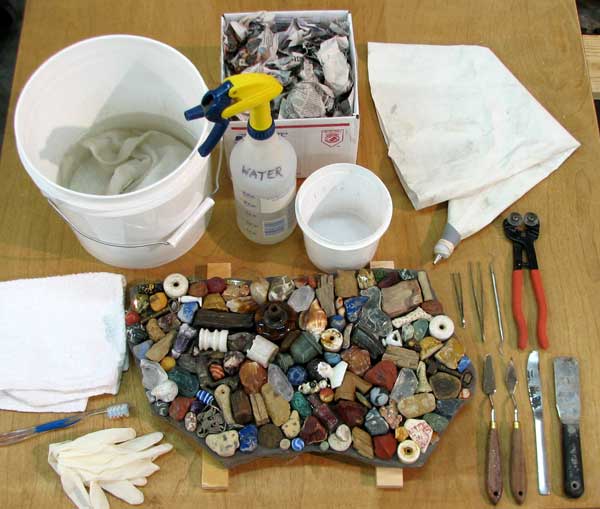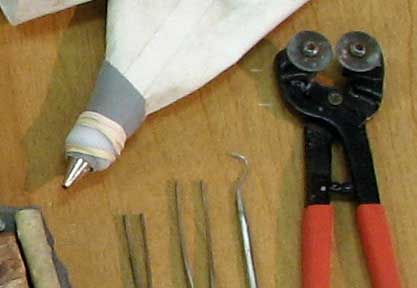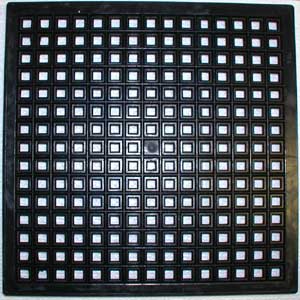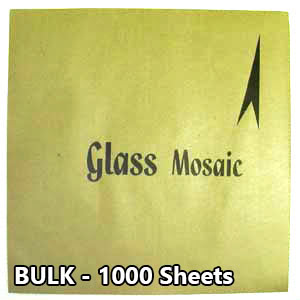BEGINNERS | GROUT | INDOOR-OUTDOOR | ADHESIVE | SURFACES | TESSERAE | CUTTING | METHOD | PATTERNS + PROJECTS | SEALING
Frequently Asked Mosaic Questions
Our frequently-asked mosaic questions page contains tons of information concerning mosaic materials and techniques, grouts, glues, mosaic tables, cutting tile, outdoor mosaics and related topics. Choose a topic category from the menu bar above, which will take you to section that includes MOST of the questions that relate to that particular subject. Or you can just scroll down through the list and browse (recommended).If you have questions about an order or how to use the store please visit our Help page or Contact Us.
See our Legal Disclaimer and Copyright Information for questions regarding reproducing this information and the responsibilities of anyone using this information to make mosaics. Our information is not intended to be a substitute for manufacturer’s instructions or using standard safety practices such as wearing gloves, dust masks or safety glasses. These items are available on our tools category. BEGINNERS- How do I start mosaicing right now?
- What safety precautions do I need to take?
- How do you grout a mosaic?
- How can I learn about grouts and how to grout?
- What safety precautions do I need to take?
- Is there anything special about mosaic grouts?
- How much grout do I need for my mosaic?
- Do I need grout with sand in it?
- What color grout should I use in my mosaic?
- I saw some clear grout. Where do I get this?
- What’s the best color grout to use?
- How do I dye grout? Where do I get colored grout?
- My grout color is wrong! How do I fix it?
- How do I dispose of grout waste?
- Why did my grout crack?
- Can I make an outdoor mosaic without grouting?
- My grout started cracking and crumbled. What did I do wrong?
- I grouted my stone mosaic and now all the stones are the same color as the grout. What can I do?
- Can I add a latex additive or polymer additive to make my grout harder?
- Can I set my tiles in grout?
- How do I mosaic an outdoor mosaic such as a patio floor, fountain or birdbath?
- How do I make an outdoor mosaic last?
- I want to put a mosaic on an aluminum table for outdoors. Is this possible?
- The mosaic birdhouse I made started coming apart very soon after I mounted it outdoors. What did I do wrong?
- Can I use glass mosaic tile outdoors?
- Can I leave my mosaic ungrouted?
- What is the best glue for indoor mosaics?
- What’s the best glue for marbles and round stones?
- What’s the best adhesive for outdoor mosaics?
- Should I use mastic or thinset mortar for my mosaic?
- How do I use thinset?
- How do I determine how much thinset to use for my found-object mosaic?
- I can only find thinset mortar in 50-pound bags. How can I use such a large bag without making a dusty mess?
- How do I put a mosaic on a wall? Won’t the tiles slide off while I’m gluing them?
- I grouted my mosaic and then noticed that glue was showing. What did I do wrong?
- Can Weldbond be used on glass mosaic tile?
- How can I use Weldbond to attach tiles to mesh for my shower if you don’t recommend Weldbond for wet mosaics?
- I want to mosaic a fiberglass sculpture. What adhesive should I use?
- Why is it bad to get glue on the sides of my tile?
- If the glue dries clear, how do I check to make sure there isn’t any on the sides of my tile before I grout my mosaic?
- What brand of thinset mortar do you use?
- How much water do I use to mix up small amounts of thinset?
- Can I mosaic on wood or plywood?
- Can I mosaic wooden furniture for outdoors?
- Can I make a mosaic on top of my formica counter top?
- Can I mosaic directly on the brick outside of a building?
- I want to put a mosaic on top of my patio table. What material should I use for the top?
- I want to mosaic on wooden furniture indoors. What do I need to do to the surface of the wood before I start?
- Can I mosaic on a plastic flower pot?
- I want to make a mosaic backsplash. What do I use for the backing?
- Can I mosaic on my glass table top?
- If I make a mosaic on 1/2-inch concrete backer board, how do I mount it to an external wall?
- Should I use 1/2 inch or 1/4 inch concrete backer board?
- Can I mix glass and ceramic tiles?
- Can I use stone and glass mosaic tile together?
- How do I use round marbles and stones in mosaics?
- How much tile do I need to cover my table or floor?
- Instead of normal tile, I want to make a mosaic from china and other materials of different thickness. How do I use materials of different thickness in a mosaic?
- I want to put a mosaic in the middle of my floor. Do my tiles in my mosaic need to be as thick as the tiles around it?
- Should I use 3/8″ or 3/4″ vitreous in my large wall mosaic, and how should I install it?
- How can I avoid ordering the wrong color tile?
- How can I order a sample board?
- How do I choose the right colors for my project?
- It’s hard for me to decide on the colors I’ll need for my project, and I’m worried the colors I see online will not match the exact color of the tiles.
- I want to copy a painting, and I don’t see the colors I need. How do I find the exact colors I need?
- Is it possible to request labeled sheets when I place an order so I can keep a record of the colors I’m using?
- Where can I find brightly-colored glazed ceramic tile such as the 4 inch tiles used to tile bathrooms?
- How do I cut glass and glass mosaic tile?
- What tool do I need to cut smalti?
- What tool do I need to cut porcelain, china and other dinnerware?
- What tool do I need to cut ceramic tile?
- Can I cut glass mosaic tile with a tile nipper?
- How can I make straight cuts in vitreous tile with the mosaic glass cutter?
- How can I cut curved shapes?
- How do I cut exact shapes from mosaic tile?
- I can’t seem to cut the exact size or shape I need, what am I doing wrong?
- Cutting up all the pieces takes too long. How can I work faster?
- How do I cut stone mosaic tile?
- How do I cut patterns from dinnerware without ruining the patterns?
- Can I use a hammer to break up my tile?
- How small can I cut 3/4″ vitreous glass tile?
- How do I transfer and enlarge mosaic patterns?
- The contact paper I’m using to mount my mosaics isn’t working. It’s dropping the tiles and is hard to handle. What type do you recommend?
- How do I use clear contact paper to make a complicated mosaic design?
- I want to mount my mosaic on mesh, but my tiles are small or not flat on the bottom. What can I do?
- How do I lay up a mosaic design on fiberglass mesh?
- Does my mosaic need to be sealed before grouting?
- Do I need to seal glass tile before I start my mosaic?
- Where can I get patterns for mosaics?
- My patio table is 48 inches wide, but the concrete backer board is only 36 inches wide. How do I make the table top?
- How do I make a mosaic stepping stone? Do I need grout or glue?
- How do I put a border or edge on my mosaic?
- How do I put a border on the edge of a mosaic coffee table?
- How do I make a mosaic urn similar to African-American memory jars?
- How can my class do a mosaic project in one session?
- I want make mosaic stepping stones with kids for a school project. What would be the least expensive, kid-friendly way to do this?
- How do I make a border for the edges of my mosaic table top?
How do I start mosaicing right now?
For an indoor project not subjected to moisture, it is very simple:- Draw a simple “cartoon” (outline) on the surface. You can copy one from a coloring book or your favorite pattern of china or fabric if you aren’t an artist
- Decide what size tiles are most appropriate for the level of detail in the design. Lay a few tiles down just to make sure the colors look right together.
- Glue the tiles to the surface one at a time with Weldbond. Make sure the gaps between the tiles are about 1/8 inch or less.
- After the glue cures for 24 hours, grout the mosaic with regular bathroom tile grout.
- For more complicated designs, you can lay the project up on mesh (by gluing sparingly with Weldbond), or you can pick up the tiles with clear contact paper. In either case, the next step would be to spread glue or cement on the surface and press the sheet of mosaic onto the glue or cement.
What safety precautions do I need to take?
Making mosaics requires basic shop safety practices:- Wear goggles when cutting mosaic materials or mixing grout.
- Mosaic materials are often sharp. Keep out of reach of children.
- Avoid breathing the dust when mixing grout.
- Wear rubber dishwashing gloves when grouting to avoid irritating your skin.
- Don’t overload patio tables with mosaic materials so that the table becomes unstable (top heavy).
- You should also make sure that the table frame can support the overall weight.
How do you grout a mosaic?
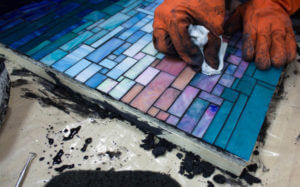
How can I learn about grouts and how to grout?
You can learn how to grout from our How To Grout Tutorial. It’s the same techniques and materials used for bathroom tile. If you were ever have a question that we haven’t covered here at our website, you can always ask at you local building material store or look at a basic book on home improvement if you need pictures. Return to TopIs there anything special about mosaic grouts?
No. The grouts and sealers you need are the same ones used for ordinary bathroom tiling, and the techniques of applying are the same. For outdoor mosaics, or mosaics which will be exposed to moisture, using thinset as the adhesive and grout is recommended. Return to TopHow much grout do I need for my mosaic?
How much grout you need depends on three things:- the area of the mosaic = L x W
- the thickness of the tiles
- the gaps between the tiles
Do I need grout with sand in it?
Unless you are trying to patch hairline cracks, the answer is emphatically yes. Sand gives the grout strength like gravel gives strength to concrete. Return to TopWhat color grout should I use in my mosaic?
Probably black. Otherwise, choose a grout color which contrast the colors of the mosaic tiles so that the design is highlighted. If there isn’t a strong contrast between the grout and the tiles, then the individual tiles are lost to the eye, and the mosaic looks more like an ordinary picture and less like a mosaic made from pieces. I avoid situations like gray grout with gray tile. A nice red-brown grout works better in that instance. The key concept is color contrast – we receive many emails from people who regret having used white grout on their project.
I saw some clear grout. Where do I get this?
Grout is concrete, and therefore opaque – You probably saw silicone sealant which should really only be used as an adhesive. Return to TopWhat’s the best color grout to use?
Usually black. Here’s why: The purpose of grout in visual terms is to make each tile distinct like a pencil line in a watercolor. Black contrasts well with most colors, causing the tiles to really pop. Avoid pure white unless you are trying to make something that looks like a little kid’s summer camp project. Some mosaic artists use white grout with white tile to make a clean flat look, but for most projects white is not the way to go because it will outshine all of your tiles. Most building material stores such as Lowe’s and Home Depot cary about 30+ colors of grout. Bring a few of each color of your tiles with you, and you can pick the color grout that works best with all the tile. Return to TopHow do I dye grout? Where do I get colored grout?
Color is best provided by the tile, not the grout. In terms of a visual element, the grout is supposed to act like a thin gray pencil line that just makes each tile distinct. I don’t think I’ve ever seen a mosaic that used colored grout that wouldn’t have looked better if all tile had been used instead. For example, let’s say you wanted red tile in pink grout. A better way to get the same color effect would be to mix in a few pink tiles randomly throughout the red tiles, or maybe use a few lines of pink tiles. Often this means you have to cut your tile just a little bit smaller. There are mineral concrete dyes sold at building material stores, and these can be used, although the range of colors is limited to black, brown, gray, terracotta, etc. Vegetable dyes such as food colors will not be permanent. If grout of a specific color is required, the best thing to do is go to a local home improvement center and compare grout swatches against your work. Return to TopMy grout color is wrong! How do I fix it?
If your mosaic is in a wet location and the grout is used to actually seal out water, then you will need to use a grout remover tool such as we sell to remove the grout and regrout with another color. However, there is an easier fix for indoor mosaics where water isn’t an issue. Artists acrylic paint can be used to paint the surface of the grout. For mosaics made from smooth glass tile, this can be done by taking a rag and wiping the paint onto the face of the mosaic similar to how you grout. The paint sticks to the grout, but the glass tile is wiped clean while the paint is still wet. Note that you can’t do this with rough or porous tile (tumbled stone, unglazed porcelain, etc.) because the paint will absorb into the tile. For these mosaics, you would need to use a small artists paint brush and carefully paint the grout lines. Return to TopHow do I dispose of grout waste?
Never pour grout down your drains. Grout is concrete, and that isn’t good for your plumbing. Instead, pour your waste in an old coffee can or milk jug and allow it to harden. In a day or so, you can pour off the water and throw the container away. For easy cleanup, I always do my grouting in the backyard instead of indoors. Return to TopWhy did my grout crack?
Grout can crack for a number or reasons:- If the backer is thin enough to flex slightly, even a miniscule amount.
- If the grout was allowed to dry out while it was trying to cure. Grout curing is a hydration reaction, not dehydration, and water is being chemically bound. Sometimes bare wood can suck the moisture out of the grout, but usually there is enough glue on the wood to prevent this. Misting can help, but misting sometimes leaches the color out of the grout.
- Wood was used instead of plywood. Natural wood sometimes splits as it ages. Plywood is less prone to splitting. (Note: use for indoor/non-wet mosaics only.) Cabinet grade plywood is best to use in this scenario.
- Using unsanded grout. Unsanded grout should only be used to fill hairline cracks. Normal grout gaps of 1/8″ require sanded grout for adequate strength.
Can I make an outdoor mosaic without grouting?
It is possible to make a permanent attachment with thinset without filling in the gaps. Depending on how much thinset is used, it would loook rough in the gaps. If more thinset is used, the space between will look better. Too much thinset and it will squeeze to the surface of the objects and make a mess. The appropriate amount of thinset is based on the size and shape of the pieces you are using. You have to make a functional and aesthetic assessment based on your tile and design. The same applies for determining what size gap to leave between the pieces. I recommend making a small sample of what you intend to do on a piece of plywood of 1 to 2 sq. ft. This will allow you to work out any issues with your materials and method before you commit to the large project. This “extra work” nearly always saves days of frustration in the end. Return to TopMy grout started cracking and crumbled. What did I do wrong?
Make sure you mix the grout according to instructions on the package with sufficient water and stir it thoroughly. It should be like a moist dough when you start with no dry material or lumps. Also, you shouldn’t let the grout dry out as it cures. Keep it covered with plastic if necessary or lightly mist with a spray bottle, taking care not to let drops accumulate on the surface of the mosaic. Return to TopI grouted my stone mosaic and now all the stones are the same color as the grout. What can I do?
You should always seal stone tiles and unglazed ceramic tiles with a tile and grout sealer BEFORE you grout. This is necessary for all porous materials that can be stained by grout. You should seal using a Stone Enhancer instead of tile and grout sealer if you want to darken and enhance the natural color of the stone. Both of these products are available at local building material stores. Ask there. For a stone mosaic that is already stained, you might want to try some of the muratic acid that contractors use to clean cement from bricks. Also ask at the building material store about this product. Return to TopCan I add a latex additive or polymer additive to make my grout harder?
Yes, but it isn’t necessary. If you want extremely hard grout, then you should probably just use thinset, which is cement with polymers added to make it sticky and give it added strength. Return to TopCan I set my tiles in grout?
No, grout isn’t sticky enough and makes a poor adhesive. If you want to set your tiles in concrete instead of glue, then use thinset, which is concrete with polymers added to make it sticky and give it added strength. You can buy a large bag of thinset from a building material store relatively cheaply. Here are some instructions I wrote for using thinset for detailed mosaic artwork. Return to TopHow do I mosaic an outdoor mosaic such as a patio floor, fountain or birdbath?
For the most part, our mosaic instructions are written for making indoor mosaics with small details. This is why we recommend the “glue-then-grout” method using Weldbond glue, a water-based adhesive with no fumes. With proper grouting and sealing, these indoor mosaics should last for generations, if not thousands of years. However, mosaics for outdoor walls, patios, fountains, birdbaths and pools are more vulnerable to moisture penetration, especially over time, and Weldbond should be avoided. While a solvent-based glue such as Liquid Nails can be used for mosaics on outdoor walls, it is probably best to avoid glues altogether and use thinset bonding mortar to attach the tiles, especially if the mosaic is in a pool, patio or fountain. Thinset bonding mortars are a cement product. Currently, we are using the Versabond brand of thinset bonding mortar for outdoor mosaics. This thinset or another brand should be available at most any building material store. Whether or not thinset mortar is used the attach the tiles, you should grout and seal your mosaic as described elsewhere in our instructions. We also have more detailed information about thinset here.We recommend the following book for more information on outdoor mosaics: Outdoor Mosaic: Original Weather-Proof Designs to Brighten Any Exterior Space by Emma Biggs, Tessa Hunkin You can also ask questions about outdoor tiling at the building material store.Also, the labels on the grouts and adhesives usually have recommendations like”indoor use only” or “water-resistant for outdooruse” or things like that, so that you can always rule out obvious mistakes. Return to Top
How do I make an outdoor mosaic last?
After the grout cures for 48 hours, seal the mosaic with tile and grout sealer from a local building material store. Return to TopI want to put a mosaic on an aluminum table for outdoors. Is this possible?
Mosaic materials are heavy. Iron patio furniture is a better candidate because aluminum furniture is often thin and flimsy. You would need to make sure that the legs could hold the weight and the top is sturdy. If the aluminum top flexes even slightly, it will crack the grout. There can also be issues with the grout reacting chemically to aluminum if it directly contacts it. Return to TopThe mosaic birdhouse I made started coming apart very soon after I mounted it outdoors. What did I do wrong?
We get emails about these falling apart all the time. If I had to make one, I would make it from foam-core tile backer board, as can be bought at local building material stores, and I would use thinset mortar to cement the pieces together. You can use concrete backer board to make the house if weight isn’t an issue. Return to TopCan I use glass mosaic tile outdoors?
Yes, glass tile is non-porous and impervious to moisture penetration and therefore frost-proof. That means glass is actually more durable than materials like ceramic tile and stone, which can be flaked away by freezing water. The weak points in an outdoor mosaic are the grout and adhesives, and the best way to protect those is by using a tile and grout sealer from the building material store. Return to TopCan I leave my mosaic ungrouted?
If the mosaic isn’t outdoors or in a wet environment, then you can leave it ungrouted. Outdoor mosaics should be grouted so that water can’t get between the tiles and freeze. Similarly, mosaics in showers and fountains and other environments should be sealed so that moisture doesn’t degrade the adhesive over time. Indoor mosaics can be ungrouted. Note that even outdoor mosaics can be “ungrouted” if the tile is pressed into thinset mortar that is thick enough to squeeze up between the tile and fill most of the gap. That is how ancient Greek and Roman mosaics were made. Return to TopWhat is the best glue for indoor mosaics?
Weldbond. It’s water based, has no fumes, dries clear and water resistant, bonds to most any surface, is non-toxic and cleans up easily. However, we prefer to use thinset bonding mortar for floors. Return to TopWhat’s the best glue for marbles and round stones?
For round objects, avoid glue and press them into thinset mortar. Return to TopWhat’s the best adhesive for outdoor mosaics?
It is probably best to avoid adhesives altogether and use thinset bonding mortar (a sticky concrete) instead. Liquid Nails Adhesive would probably be best for outdoors, if you have to use an adhesive. It’s thick and tarry and bonds to anything, but it is solvent based and the fumes are an issue. We use Weldbond adhesive for mosaics for indoor mosaics where water or rain isn’t an issue because there aren’t any fumes and clean up is much easier. We have used Weldbond successfully on several outdoor projects, but these pieces were grouted and sealed very well, and they were vertical surfaces that didn’t have water standing on them. Liquid Nails Adhesive might have been a better choice, but thinset mortar is recommended instead of any adhesive. Return to TopShould I use mastic or thinset mortar for my mosaic?
Thinset bonding mortar should be used for outdoor mosaics and mosaics where water is an issue, such as shower floors, pools and fountains. Mastic is used to attach ceramic tile to bathroom walls. For indoor artistic mosaics, we use Weldbond, which is a white PVA adhesive. Using Mastic on outdoor mosaics can lead to disastrous results. Return to TopHow do I use thinset?
You should read and follow the instructions on the package for mixing, handling and disposal. In brief, thinset is like grout and other concrete products. This means that the best place to mix them up is outside, and you should wear a dust mask if you have trouble mixing it up without creating a lot of dust. (Some artists merely stand upwind and mist it with a spray bottle until they get it mixed up.) Breathing silica (such as dust on a windy day) can have long term health effects on the lungs. I usually mix up about 1 or 2 pounds at a time and smear it on the wall with a small trowel or putty knife. I spread it out to about 1/8″ to 1/4″ thick and press my mixed materials directly into the concrete. I wear rubber examination gloves and keep a damp rag so I can wipe away any excess that squeezes up to the face of the tiles. If you keep the concrete in the bucket covered so that it doesn’t dry out, then it should stay workable for several hours. I made the mosaic columns at the gallery using thinset mortar in this way. I always keep a small bucket with a little water and rag to clean my hands from time to time and a dry rag in my lap. We have very detailed instructions for using thinset here. Return to TopHow do I determine how much thinset to use for my found-object mosaic?
When using found objects, the best method is to adapt how much thinset you spread as you go along, for each piece or a small set of pieces. Be careful about using too much thinset, as it will squeeze to the surface of the objects and make a mess. As you are working, you will probably develop a rhythm in relation to the different pieces and their sizes relative to the amount of thinset you need. Also, when grouting, instead of trying to rub in then wipe off the grout, the typical method for flat tile, fill in the voids selectively with a grouting bag. Return to TopI can only find thinset mortar in 50-pound bags. How can I use such a large bag without making a dusty mess?
I can only find thinset mortar in 50-pound bags. How can I use such a large bag without making a dusty mess? Buy a 5-gallon bucket with lid at the same store where you buy the thinset. Put the whole bag inside the bucket, bag and all. (Do not dump it in because that would create a lot of dust.) Slit the top of the bag open and scoop out thinset as you need it. You can use a plastic cup or scoop or soup ladel or whatever you have. The point is that you don’t try to pour the thinset. Keep the lid on the bucket so that humidity from the air doesn’t clump the thinset over time, and you can use the same bag for small projects for years. Return to TopHow do I put a mosaic on a wall? Won’t the tiles slide off while I’m gluing them?
Glue your mosaic tiles to fiberglass mesh at your work table. (Make sure your table is covered with construction plastic or parchment paper, such as used in baking, so that you don’t glue everything to the table. Most people cut the mesh in smaller sections, usually 12 inch x 12 inch, because it is difficult to handle sheets of mosaic larger than 1 sq foot. Most people use Weldbond (sparingly) to attach tiles to mesh. When the mesh is dry in about 24 to 48 hours, you are ready to mount this assembly to the wall. This is done by spreading thinset or mastic or Weldbond on the wall itself and pressing the mesh onto the wall. After this cures, in about 48 hours, you can grout the mosaic in place. Return to TopI grouted my mosaic and then noticed that glue was showing. What did I do wrong?
You need to always clean up excess glue before you grout. I also use the following technique when using Weldbond indoors or outdoors. After the glue has dried for a day or two, I come back and mist the mosaic with water. After about 10 minutes, any traces of glue that are sticking up on the sides of the tile will start to turn white. I then take a razor knife like a box cutter or exacto knife and trim away the excess glue. This cleaning step ensures that there will be no glue sticking up and not covered by grout. Return to TopCan Weldbond be used on glass mosaic tile?
Yes. It bonds to most any material. Return to TopHow can I use Weldbond to attach tiles to mesh for my shower if you don’t recommend Weldbond for wet mosaics?
Weldbond is the adhesive commonly used to attach tiles to the mesh. The problem is that some novice users get adhesive on the sides of the tile. This means that the grout can’t properly cover the adhesive, and water/moisture can wick over time to the back of the tile. However, if the gluing and grouting are done correctly, and the mosaic is sealed with grout or concrete sealer, the mosaic can last for a long time. I use Weldbond sparingly so that there is some surface of the tile that can bond directly to the cement, thus making a more durable bond. I use thinset (sticky concrete) to attach the mosaic to the wall. I also use the same thinset for grouting. Some people avoid the whole issue of water penetrating to the glue by using paper for the reverse method and not using mesh. In the reverse method, the mosaic is laid out face down on sticky paper like clear contact paper, or mosaic mounting film. When finished, the sheet is pressed into thinset, and after the thinset hardens, the contact paper is peeled off. People also use brown mosaic paper instead of contact paper. The mosaic it attached to the paper using dilute glue like Elmers, and after the mosaic is attached to the wall, the paper is misted with water and peeled off. I hope this helps! Return to TopI want to mosaic a fiberglass sculpture. What adhesive should I use?
We mosaic on cement bases, so we use thinset (sticky concrete) for attaching tiles. For fiberglass bases, most artists recommend an epoxy or a construction adhesive like Liquid Nails Outdoor Formula. You should test your adhesive on the fiberglass substrate by gluing the tile in an inconspicuous place on the sculpture. Keep in mind that you are testing not only how well the adhesive bonds but also how easy it is to work with and if it has bad fumes, etc. Note that some artist have reported using Weldbond, but I am not sure about that because Weldbond doesn’t bond to most plastics. As always, you should test adhesives by gluing on a tile and seeing how difficult it is to pry the tile off. Also, scuffing the surface with a coarse-grit sandpaper helps ensure a stronger bond. Return to TopWhy is it bad to get glue on the sides of my tile?
If a thin residue of glue sticks up above the grout, water can wick down the glue over time and cause the tile to pop off. Even if water isn’t an issue, it can still interfer with the grouting process and make the grout look messy. Return to TopIf the glue dries clear, how do I check to make sure there isn’t any on the sides of my tile before I grout my mosaic?
Mist the mosaic very well with water. Within a few minutes to ten minutes, any thin residue of PVA glue will start to turn white. You can use a box cutter or knife to scrape off the residue. Return to TopWhat brand of thinset mortar do you use?
We use Versabond brand bought at Home Depot. Return to TopHow much water do I use to mix up small amounts of thinset?
We use 0.25 pounds of water per 1 pound of thinset. It’s a good idea to check the instructions and labeling on whatever material you buy before using it. Return to TopCan I mosaic on wood or plywood?
Indoors, these materials can be used with no problems. Outdoor use requires some thought and preparation, and I would definitely avoid wood outdoors if possible. I would seal the back and edges with water seal or an oil-based paint. Fine mosaic work takes an investment in time and materials. It only makes sense to mosaic on a backing that is resistant to moisture and decay. Thus the best material to use for an outdoor mosaic is foam-core tile backer board from a local building material store. It is cheap, easy to cut, and resists the elements. Wood and even plywood make great backings for DRY INDOOR mosaics such as mirror frames and wall plaques. For these indoor projects, we recommend using cabinet grade plywood. Return to TopCan I mosaic wooden furniture for outdoors?
Only if you don’t care whether or not it lasts. Outdoor mosaics should be on concrete or concrete backer board. Concrete backer board can be purchased cheaply at local building material stores and can be used as the mosaic surface in metal patio tables. This is the best way to make an outdoor mosaic table. This article, Materials and Methods for Outdoor Mosaic Tables, can give you an overview. Return to TopCan I make a mosaic on top of my formica counter top?
People have done so, but if the mosaic is an interesting design, you’ll probably want to take the formica off and use a base that is sure to last. The engineer in me hates the idea of wasting time and material on something that might not last. Also, I’m not sure what adhesive you would use to bond to formica because the top of formica is made to resist things sticking to it. Return to TopCan I mosaic directly on the brick outside of a building?
The brick is fine, unless it is old and slightly crumbling, and then you might need to buff off the loose material. I always scrub exterior walls with a rotary wire brush and plaster the surface smooth and level with thinset a few days before tiling. Return to TopI want to put a mosaic on top of my patio table. What material should I use for the top?
Foam-core tile backer boards are best because they are relatively lightweight compared to concrete backer board. Brands include Schluter Kerdi-board, USG Durock, Laticrete Hydroban, Johns Manville GoBoard, and Wedi board. I suspect USG Durock will be the most affordable in most places. You can use concrete backer board, but make sure that you don’t overload the table or make it too heavy or unstable. Whatever you use, it is best if the rim of the table covers the edge of the mosaic or at least the backer. This article, Materials and Methods for Outdoor Mosaic Tables, can give you an overview.Return to TopI want to mosaic on wooden furniture indoors. What do I need to do to the surface of the wood before I start?
I’ve mosaiced on raw wood and wood with stain, but not on top of wood sealer. I think raw wood is best because that probably allows the best bonding of glue and grout. If you’re concerned about the possibility of the furniture warping over the years due to humidity, you can coat it with Weldbond. This seals the wood from moisture, but still provides a surface that is good for bonding. Some people mix in a little water with the Weldbond so that they can paint it on with a paintbrush. A few coats should ensure that the wood is sealed. Once that is dry, you can begin the mosaic. Another thing that you can due to help your piece last for generations is to seal the grout when you are done with a non-gloss grout sealer. I always use non-gloss because that doesn’t change the color or appearance of the mosaic the way that gloss sealers can. Return to TopCan I mosaic on a plastic flower pot?
We don’t recommend plastic for backers. Even a sloppy half-hearted mosaic takes some work. Once you are done, you will be glad you spent a little bit of time to find a backer that will last. Return to TopI want to make a mosaic backsplash. What do I use for the backing?
Concrete backer board from your local building material store. It’s cheap and can be cut and broken by scoring with a box cutter. Either glue the material on the backer board and mount the board to the studs in the wall or mount the board and glue mosaic material to the board. In the latter case, you might want to glue the tiles to fiberglass mesh and then glue the whole piece of mesh to the backer. In either case, you grout the tiles in place on the wall. Return to TopCan I mosaic on my glass table top?
Mosaic tile and grout are heavy. Don’t create a safety problem by using glass as a base. Simply replace the glass with a piece of wood. People report that translucent Lexan can be used if you need a translucent base. Return to TopIf I make a mosaic on 1/2-inch concrete backer board, how do I mount it to an external wall?
Consider using foam-core tile backer board as an alternative to concrete backer board if weight is an issue. Regardless of the backer used, you need to frame and protect the edges. One solution is to have a local welder fabricate some frames from 3/4″ angle iron to fit around the edges of the mosaic. The frames can have mounting holes made from washers welded to the outside of the frame. The frame should be spray painted with multiple coat of outdoor paint in a matte color, preferably umber or something neutral depending on the color of the wall where they will be mounted. The mosaic is attached to the wall inside the frame with thinset or an outdoor construction adhesive such as Liquid Nails Outdoor formula. Return to TopShould I use 1/2 inch or 1/4 inch concrete backer board?
The 1/4 inch backer board is too thin for floors and bends and punctures more easily. I only use 1/4″ when I laminate it to plywood. Return to TopCan I mix glass and ceramic tiles?
As long as the colors look right, you can mix any materials, except that you need to make sure they are close to being the same thickness. You don’t have to wory about thickness if you are pressing them into wet concrete of course. On the other hand, a difference in thickness might add interest to a fine art mosaic not used as a surface.Return to TopCan I use stone and glass mosaic tile together?
The two materials usually have different thickness. If you are pushing the tiles into concrete or mortar, then it doesn’t matter. If you are gluing to a surface, the difference in heights will be visible. This makes grouting a little more difficult, but it hasn’t stopped me from doing it on many of my pieces at the gallery. Return to TopHow do I use round marbles and stones in mosaics?
If you’re pushing them into wet concrete as you would for a stepping stone, then no problem. If you are gluing them to a surface and then grouting, make sure you use something thick and tarry like Liquid Nails brand adhesive. Also make sure that you use thicker tile around the marbles so they don’t stick out so far. Otherwise there is a danger that the marbles may pop off when you grout. I always wear grouting gloves and grout with my fingers. This allows me to remove all excess grout without bumping the marbles too much. Return to TopHow much tile do I need to cover my table or floor?
We have a Tile Calculator page in the top menu bar. Return to TopInstead of normal tile, I want to make a mosaic from china and other materials of different thickness. How do I use materials of different thickness in a mosaic?
Actually, there is a good way to use the millefiori, china and other objects of different thickness. To use these materials, the best way is to use thinset bonding mortar (a type of sticky concrete) instead of glue. It’s available at building material stores. I usually mix up about 1 or 2 pounds at a time and smear it on the wall with a small trowel or putty knife. I spread it out to about 1/8″ to 1/4″ thick and press my mixed materials directly into the concrete. I wear rubber gloves and keep a damp rag so I can wipe away any excess that squeezes up to the face of the tiles. If you keep the concrete in the bucket covered so that it doesn’t dry out, then it should stay workable for several hours. I made the mosaic columns at the gallery using thinset mortar in this way. I always keep a small bucket with a little water and rag to clean my hands from time to time and a dry rag in my lap. That way the thin pieces can have more concrete underneath, like in the “Plum Tree Mosaic.” Return to TopI want to put a mosaic in the middle of my floor. Do my tiles in my mosaic need to be as thick as the tiles around it?
Yes and No. You want the surface to be even for safety and durability reasons, and the easiest way to do that is to do that is to use tile of the same thickness. You can use tile of different thickness if you build up the rest of the area with concrete or mortar. Keep in mind that thinset mortar contracts slightly as it cures, and so you would need to build up the area in advance of tiling. Return to TopShould I use 3/8″ or 3/4″ vitreous in my large wall mosaic, and how should I install it?
The vitreous glass is highly recommended for cost, ease of cutting and the range of colors available. The 3/4″ is much more cost effective than the 3/8″ minis. The 3/4″ tile can be cut into quarters and yield four 3/8″ pieces. The method of attaching and even the choice of tile depends on how large the mosaic is going to be. That is determined in large part by the design or picture you want to create. Specifically, it depends on what is the smallest detail you want to depict in the mosaic. You shouldn’t try to depict any detail smaller than what you can render with a few tiles. This is the starting point.- Select preliminary design.
- Look at smallest details in the design and decide if you can render that in a few tiles. Note: Vitreous tile is embossed with ridges on the back that make it difficult to use if you if you try to cut it up too small. I recommend experimenting with real tile to figure this out. It saves a lot of frustration.
- Determine how large the design would have to be based on the results of #2.
- See if the room can accommodate a mosaic that large or that small. Does it look right aesthetically at that size and work with the other design elements?
- Determine method of installation. If the mosaic is large, then create it on mesh. If the mosaic is resonably small or medium size, create on a backer and mount the finished mosaic on the wall by drilling into the studs.
How can I avoid ordering the wrong color tile?
The correct way to order tile is to make a small exploratory order to see what different colors look like NEXT TO EACH OTHER before you order full quantities for the project itself. (Never start the project with partial quantities due to the potential for batch variations.) It is nearly impossible to order five or six colors for a particular project and have all of the colors be correct, although some novices assume that they can. There are several reasons for this, and it is NOT just a question of computer graphics cards or the limitations of digital photography. Any fine-art painter will tell you that it is impossible to tell what a color will look like until it is applied to the canvas next to the other colors. Biopsychologists and human-factor engineers will tell you much the same thing. It really helps to have a small library of different colors and materials before you start. We carry sample boards, and can put together sample sets for you. This means it actually helps to have a few “wrong” colors lying aroung your studio. What is “wrong” for one mosaic, will be perfect for a later project. I’ve noticed time and again that I wouldn’t have been aware of this perfect color if I didn’t have it already lying around. Thank heaven for “wrong” tile. Return to TopHow can I order a sample board?
We don’t offer sample boards because tile colors vary by manufacturer batch. For a variety of economic and technical reasons, tile colors aren’t tightly controlled like the colors of paint and other products. Architectural suppliers pretend this problem doesn’t exist because they can afford to send a sample if needed before each order because the orders are typically for 50 sq ft or more. We do offer 10-item samples for the cost of postage. This way, we can provide samples from our current manufacturer batches on an as-needed basis without giving the false impression that colors are fixed consistently the way paint is. Return to TopHow do I choose the right colors for my project?
When starting any new mosaic project, try out different colors to see which work best. It helps to have odds and ends of different colors in small amounts as a “library” for exploring different colors. This is why it helps to have samples of extra colors lying around. If you don’t already have extra tile colors around, then ordering samples is a good idea, especially if your mosaic will be large. If you continue to do mosaics, it won’t be long before you have your own color library. I rarely complete a mosaic using all the tiles I originally ordered for it. I usually end up realizing that one of the sample colors I have lying around works better than what I had intended to use, and then I have to place a second or third order. I recommend making a small pilot order of small amounts of many different colors before making firm decisions about a larger order for the actual project. If some goes unused, it’s not a problem because these scraps serve as “seeds” for future ideas. If you are just beginning, you can order a starter kit and request that we ship specific colors you choose. To do so, paste the names of 12 colors of Kaleidoscope in the Special Instructions during checkout. Return to TopIt’s hard for me to decide on the colors I’ll need for my project, and I’m worried the colors I see online will not match the exact color of the tiles.
When choosing colors for a mosaic design, instead of trying to match the colors of a painting or picture, I take the colors I have available and lay them in various combinations on a sketch of the design. A color can look completely different based on what colors are around it. Even if computer images were completely accurate, you would still need to play with the tiles before you knew for sure which colors were right. The bottom line is that you should have a small amount of many different colors laying around to experiment with before you commit to any design. That’s why we sell sheets of 25 tiles. In general, I recommend that customers make a small “exploratory order” before ordering the full quantities for the project. If a person has never made a mosaic before, I also recommend that they make a small mosaic plaque on a piece of plywood before they do the larger project to work out materials and methods first. People regularly report that the “delay” of doing the small project often saves them days of labor or disastrous mistakes on the large project. Return to TopI want to copy a painting, and I don’t see the colors I need. How do I find the exact colors I need?
As you’ve noticed, the color palette is limited. The only product that is good for matching colors exactly is smalti, such as we carry, and is also offered at www.dimosaico.com and www.smalti.com. On the other hand, I always think of mosaic as an exercise in working in a limited color pallet, and that is what makes the old mosaics so fascinating. I see more and more modern mosaics that are more or less reproductions of paintings or made to look like paintings in terms of color pallet. To me this art seems a little hollow in the sense that it has more technical resource than imagination. (I’m sure other people would disagree.) Return to TopIs it possible to request labeled sheets when I place an order so I can keep a record of the colors I’m using?
Labeled sheets can actually be problematic. The sheet can completely be completely consumed while in the heat of an art project or lost while soaking the tile to remove paper. Here’s what we recommend: take the invoice and tape one tile on each color on the side of the invoice. The tiles only have to be in order. You don’t have to squeeze them beside each name. This has several advantages:- Your record isn’t nearly as like to be destroyed in the studio.
- You not only have the name of the tile, you also have the date it was ordered. (This is important because colors vary over time, so you might need to know how long ago you ordered before assuming the color is the same.)
- You have the price you paid for the color, which is important for cost comparisons or bidding on commissions.
Where can I find brightly-colored glazed ceramic tile such as the 4 inch tiles used to tile bathrooms?
Brightly colored ceramic tiles could be bought at any building material store in the 1970s and even into the 1980s, but I think they are as rare as dodo birds now. People just don’t tile bathrooms in bright colors any more, so the factories stopped making them. Return to TopHow do I cut glass and glass mosaic tile?
You need a mosaic glass cutter that has two blades shaped like wheels. A regular tile nipper tends to crush most glass but can be used with certain types of vitreous glass mosaic tile. Return to TopWhat tool do I need to cut smalti?
Mosaic glass cutter. A regular tile nipper tends to crush most glass. Return to TopWhat tool do I need to cut porcelain, china and other dinnerware?
Hard dinnerware can be cut with a regular nipper, but a Compound Tile Nipper is best. Return to TopWhat tool do I need to cut ceramic tile?
Tile Nipper. Return to TopCan I cut glass mosaic tile with a tile nipper?
The wheeled glass cutter is better. It works like a tile nipper only it has wheel-shaped blades that allow it to cut glass cleaner instead of crushing it. Return to TopHow can I make straight cuts in vitreous tile with the mosaic glass cutter?
I can cut vitreous in equal halves and quarters fairly consistently with the mosaic glass cutter, although the glassier reds, oranges and yellows can be slightly more difficult. I notice that I am more likely to get a crecent-shaped cut if I allow the tile to rotate, and I expect some people might have less finger strength or flinch at the moment of cutting, so they might not get the same results for that reason alone. However, the most important piece of advice I can give is to cut with the tile upside down so that you can see the scoring on the bottom as you cut and make sure you aren’t positioning one blade on top of a ridge, which will almost always cause the tile to rotate in the blades at the moment of cutting. Return to TopHow can I cut curved shapes?
Look at any book on classical or Renaissance mosaics. They don’t use curved pieces. The artists make curved shapes by putting small pieces together. Return to TopHow do I cut exact shapes from mosaic tile?
Glass tile can be difficult to cut in a predictable shape due to the scoring on the backsides of the tiles. That is why you should cut the tiles upside down so that you can see how the embossed ridges might be affecting your cut. (Wear safety glasses as always.) Here’s the more important information: The pieces shouldn’t be perfect squares or triangle. The irregularity ensures a grout gap even when the tiles are pressed close together. More importantly, non-uniform squares will make the mosaic much more interesting visually than uniform squares. (Look at traditional mosaics if you doubt this.) Perfect squares make a mosaic look like it was made from a kit. A little irregularity makes a mosaic look more like hand-made art. Tiles should never be “shaped” or custom cut. Instead, cut up about 4 or 5 tiles, and then select the piece that is closest in shape to what you need. You will find that you work faster that way with much less stress. Return to TopI can’t seem to cut the exact size or shape I need, what am I doing wrong?
Choosing the best piece out of 5 to 10 random pieces is much easier than trimming a single piece down to size, especially if the material being used is brittle or breaks unpredictably. Also, some tile such as vitreous glass has embossed patterns or ridges on the bottom of the tile to help the tile bond more securely to the cement, and these ridges can interfer with the blade of the cutter. When cutting these tiles, then hold them upside down as you cut so that you can see how the cutting blade is resting between or across the ridges. It also helps if you hold the tile firmly during cutting to prevent it from rotating. Return to TopCutting up all the pieces takes too long. How can I work faster?
Cutting up all the pieces takes too long. How can I work faster? One common mistake is to cut or trim each piece as you use it. This is slow and tedious in itself, and it also requires that you constantly pick up and put down the cutting tool. While some trimming is unavoidable, it is much easier to select what you need from handful of pieces that were already cut up “randomly” than it is to custom trim each piece. The only potential problem with cutting up tile randomly before you start arranging them is that you could end up with a lot of shapes and sizes that aren’t useable. Here is the procedure we use to minize unusable pieces:- Estimate the size and shape of the piece you need.
- Cut up 3 or 4 (or 10) pieces in that size and shape range.
- Use the piece that fits best or cut up 3 or 4 new candidates.
- Keep the rejects in a tray and try to use these pieces in other places in the mosaic later.
- Pay attention to the sizes and shapes of the rejects in your tray that you don’t seem to use as often.
- Avoid cutting similar pieces.
How do I cut stone mosaic tile?
Traditionally, mosaic stone is cut with a hammer and hardie (small anvil), but many people use a tile nipper. Here’s the method I use: Since the stone doesn’t break that cleanly, and the cuts often mar the finish of the stone, I design my mosaic so that as few pieces as possible have to be cut. Most pieces in the design are full squares, and the few pieces I have to cut are cut with a tile nipper or small hammer and small chisel. This means you should probably buy small pieces (such as 3/8″ as opposed to 9/16″) to make your design. Return to TopHow do I cut patterns from dinnerware without ruining the patterns?
Some porcelain dinnerware can be extremely hard. The Compound Nippers for Hard Tile take less force than the regular tile nippers, and so they may give you more control in your cuts. However, no compression tool can make continuous long cuts like a pair of scissors cutting paper. Even with the compound nippers, you will still be snipping off chunks one at a time and be at risk of breaking any pattern that might be on the dinnerware. Most pique assiette work features a pattern such as a flower or face that was carefully cut out, but notice that these select pieces are almost always surrounded by pieces of the same pattern that are broken more randomly. That should give you a clue about how the dinnerware was cut up: The artist cut up several identical plates before she got the pattern she needed for the centerpiece, and she used all her “scrap” for the surrounding tiles. The point is that you shouldn’t count on getting the piece you need from just one plate. Every time you snip, there is a chance that the plate will break in the wrong place and go right through the pattern. However, if you see a pique-assiette mosaic where the dinnerware patterns are more uniformly cut, you can assume one or more of the following:- The person used a wet saw (powersaw used by installers of ceramic tile).
- The person discarded a large amount of scrap.
- The dinnerware used just happened to break more predictably than most. (Ceramic materials vary considerably. Some types will be more friendly than others.)
- Plates of normal thickness of about 1/8″ or more are much more easy to cut and use than thin eggshell china.
- Thin eggshell china is difficult to grout. The curvature of the pieces often means sharp edges will be sticking up.
- Cutting out distinct parts of a pattern such as a flower is difficult and takes practice and usually generates scrap.
- Allow yourself several practice plates, so when you approach those with the pattern that is most important to you, you’ll be ready.
Can I use a hammer to break up my tile?
You can if you don’t mind wasting a lot of your material and producing lots of dust and useless tiny sharp pieces. Sometimes a hammer is useful for breaking up large ceramic tile or unpatterned dinnerware, but never glass tile or stained glass. You just waste too much material that way. If you do use a hammer on dinnerware, wrap it in an old towel to minimize and contain small shards. Return to TopHow small can I cut 3/4″ vitreous glass tile?
The 3/4″ vitreous usually can be trimmed to halves, thirds and quarters with no problem. If you attempt to cut it smaller than that, then the embossed ridges on the back sides can interfer with the cuts you are trying to make or the ability of your pieces to lay flat once cut. Return to TopHow do I transfer and enlarge mosaic patterns?
A simple procedure for transferring and enlarging mosaic patterns is explained on our page for Inexpensive Mosaic Patterns. Return to TopThe contact paper I’m using to mount my mosaics isn’t working. It’s dropping the tiles and is hard to handle.
I use the regular clear contact paper from the grocery store. It can be problematic as well. Most people use the mosaic mounting paper we sell with diluted Weldbond. Here’s how I work indirect: I draw my pattern on piece of butcher paper. I lay a piece of clear contact paper on the pattern with the sticky side up. I lay my tiles face down on the sticky contact paper. Keep in mind that this method reverses the image from left to right. The easiest way to compensate for this is to draw the pattern on the butcher paper as you would like it to look, then turn the butcher paper over and trace the pattern from the other side, then use this side as your pattern for laying up the tile. Whatever mounting paper you use, I highly recommend making a small “experiment” mosaic first to make sure you know how to handle and apply the mosaic. A square foot of mosaic attached to clear contact paper can be heavy and unwieldy. Sometimes tile will fall off while you are about to press the mosaic into the cement. Make sure you have done a quick and dirty mosaic on a scrap piece of board before you invest a lot of time in laying up the real mosaic because it’s awful to suddenly realize you don’t have the confidence to mount what you’ve spent so much time laying up. Return to TopHow do I use clear contact paper to make a complicated mosaic design?
To make a simple mosaic, you sketch an outline or “cartoon” on the surface. Then you lay tile on the drawing until you are comfortable with the colors, the size of the tile, how it will look, etc. Then you start gluing the tiles on one by one. The problem is that this takes forever and is tedious because your fingers become sticky with glue and you disturb other tiles as you work. The solution is simple: Lay the tile out without gluing them down. Keep going until the design is complete. Then carefully press a piece of clear contact paper down on the tiles. (It might be useful to have an extra pair of hands help you do this, and make sure you start in the middle and work outward to avoid wrinkles, which can be disastrous.) Spend as much time as needed pressing the contact paper down, rubbing carefully to ensure that each tile is Then CAREFULLY slide the mosaic onto a temporary board or table top just to store it for the time being. Now you can apply thinset or adhesive to your surface and press the mosaic into the thinset or adhesive. After the cement is fully cured in 24 to 48 hours, you can peel off the contact paper and grout the mosaic. An alternative method that may be easier for some people: You can lay clear contact paper upside down on your outline and stick the tiles face-down onto the contact paper. Note that this requires that the tiles be attached to the paper upside down. This means that you are creating your design in left-right reverse because the paper/tiles will be flipped over when installed. Return to TopI want to mount my mosaic on mesh, but my tiles are small or not flat on the bottom. What can I do?
Small tile isn’t mounted on mesh. Instead, use mounting paper or clear contact paper instead to temporarily mount the tile FACE down. Paper mounted sheets are pressed into thinset mortar or adhesive, and the adhesive is allowed to harden. Then the paper is removed by misting with water and peeled off. Return to TopHow do I lay up a mosaic design on fiberglass mesh?
The normal procedure is to place clear plastic kitchen wrap or construction plastic over your pattern (usually an outline drawn on paper) and then lay the fiberglass mesh on top of that. Remember to tack or tape the corners down to keep the mesh from moving as you work. Tile is glued to the mesh with a white PVA adhesive such as Weldbond. Take care not to get glue on the sides of the tile, which could allow moisture to wick underneath the grout over time. Leave some of the back of the tile uncovered by glue so that thinset mortar can bond directly to the glass. Tip: Sometimes it helps to trace the outline of the pattern onto the mesh with a black Sharpie marker before you begin gluing tile down and things get messy. Return to TopDoes my mosaic need to be sealed before grouting?
Only porous materials such as unpolished stone and unglazed porcelain need to be sealed to prevent staining. Things like smooth glass shouldn’t stain. I use TileLab brand “Grout & Tile Sealer” for a normal seal. I use TileLab brand “Stone Enhancer & Sealer” if I want to slightly enhance/darken the stone colors (recommended). Both of these are available at hardware stores. I apply grout sealer with a small artists paint brush. I am careful to minimize the amount of sealer that drips to the sides where the grout should go. Make sure you don’t put on so much that you get it down in the cracks. You only want to seal the face. I do this before I grout. I also seal the grout after it cures for two or three days. Return to TopDo I need to seal glass tile before I start my mosaic?
I only seal stone and unglazed ceramics before I grout. I don’t worry about glass because it isn’t porous the way stone is, and it can’t be stained by the grout. Stone and Grout Sealer is available at local building material stores. I use non-gloss sealer because it doesn’t change the color or shine of the mosaic. Return to TopWhere can I get patterns for mosaics?
We have a page for finding and using Inexpensive Mosaic Patterns. Return to TopMy patio table is 48 inches wide, but the concrete backer board is only 36 inches wide. How do I make the table top?
The 48″ patio tables are very common. You should have a welder put some supports of angle iron underneath, and the concrete board is glued to that. The table probably needs to be reinforced anyway, and you should make sure that you aren’t making the table too heavy for the legs or top-heavy or unstable. Return to TopHow do I make a mosaic stepping stone? Do I need grout or glue?
Grout and glue are not needed. Most mosaic stepping stones are made by pouring concrete into a mold and pressing in mosaic tiles while the concrete is still wet. We have an in-depth stepping stone tutorial that shows how to make one using concrete. You can get ordinary concrete mix from a local building material store. Make sure you pick out most of the larger rocks before you mix it. You can use a plastic dishpan as a mold or cut off a plastic 5-gallon bucket. Make sure you rub vaseline into it so the stone will come out later. Pour the concrete about 2 1/2 to 3 inches thick. Don’t buy the stepping stone kits that come with ready-made designs. They are boring and unoriginal. You can make beautiful stones just by collecting your own marbles, beach glass, shells, etc. An alternative way of making a stepping stone is to buy a stepping stone from a lawn and garden store and attach tiles to it using thinset. Keep in mind that you might need to scuff the stepping stone with a wire brush to remove any invisible sealers that might keep the thinset from bonding securely. Return to TopHow do I put a border or edge on my mosaic?
There are two different approaches for handling the edges of mosaics: 1. “Roman Fragment” In museums, small fragments of Roman mosaics are often displayed on small stands with the edges left unfinished. When I make small mosaic plaques, I will often use a flat piece of fieldstone from a lawn and garden center because I like the non-square shapes. For square shapes, I laminate 1/4″ concrete board to 1/4″ plywood. I mosaic to the edge but make sure that no tile extends beyond the edge. Once I have grouted the mosaic and let it cure, I will go back with medium grit sandpaper and clean up the edge. Then I seal the back and edges with acrylic paint. This technique should only be used on small mosaics because tiles can easily be knocked loose from the unprotected edges. 2. “Picture Frame” For larger mosaics, I build a frame from 1.5″ wide oak, but you can use a cheaper and softer variety of wood. Usually I make the frame before I create the mosaic by glueing the frame to the plywood wood backer and then cutting a smaller piece of concrete board to fit inside the frame. You should find a friend with a miter saw to cut the frame for you because a miter saw can quickly and accurately cut the ends of the wood strips at a 45 degree angle so that they fit together like the corners of a picture frame. It is possible to build a frame around a mosaic you have already made, but again it helps to have a miter saw or a friend with one. This method is recommended because you can drill through the frame to mount your mosaic into the studs of the wall. Return to TopHow do I put a border on the edge of a mosaic coffee table?
Hardwood trims and moldings work very well for making a “picture frame” type of border on the surfaces of wooden coffee tables. The molding can be attached with carpenter’s glue. Tip: Stain a sample piece of the molding to make sure that it can be stained close enough in color to the color of the coffee table. Return to TopHow do I make a mosaic urn similar to African-American memory jars?
African-American memory jars were home-made funeral urns that were covered with personal items that belonged to the deceased loved one. The objects included buttons, cigarette lighters, keys, pieces of favorite ceramics, etc. I’ve not done any research to find out what was used originally to attach the pieces, but I always use thinset in multi-media mosaics made of these type objects. Tip: You can turn the urn on its side and do a side each night. Return to TopHow can my class do a mosaic project in one session?
Creating a mosaic in one session isn’t that realistic, but it can be done, especially if the class can finish up what they start on their own. The class should be all about glueing the tiles down, because that is where the art happens. The mosaics should then be grouted later outside of class, either by the instructor or by the students who are given a handout of instructions and mistakes to avoid. You should review those instructions at the end of the class. The concept is sort of like the you-paint-it ceramic stores where customers come in and paint there designs on the pot, but the pot is fired later by the store. Trying to glue and grout in the same class does nothing but produce disasters. Return to TopI want make mosaic stepping stones with kids for a school project. What would be the least expensive, kid-friendly way to do this?
Our vitreous tile is recommended due to price, range of colors and ease of cutting. There is also a way to do this cheaply using local materials. Large bags of concrete can be bought for a few dollars at a local building material store. Stepping stone molds can be improvised: use plastic dish pans, litter boxes and the bottoms of 5-gallon buckets. Grease the molds with Vaseline to ensure easy removal of stepping stones. Sources of tile: broken ceramic tile from local tile show rooms. They will often donate discontinued and damaged tile; broken pieces of old plates from thrift stores and parents garages. Our vitreous tile is the cheapest tile we have. Use this as an opportunity to show the kids how to improvise as true artists: have them bring in marbles, old ceramic figurines, rocks, old souvenirs and other things and make a few stones. It will be a great learning experience for them. If you decide to do indoor mosaics with them, I recommend backers/substrates cut from 1/2″ sanded plywood. You can build a frame around the backer with wooden molding. Alternatively, I have seen people take wooden picture frames and cut a backer to fit the frame. It all comes down to what you have on hand or what you can get cheaply. Return to TopHow do I make a border for the edges of my mosaic table top?
For wooden tables, there are several edge options, which might or might not be appropriate depending on the size, thickness and finish of the table top:- Use a plunge router to cut out the area where the mosaic should go.
- Make a border/frame from wood molding from the building material store.
- Make a border from a different type of tile with a rounded edge, such as ceramic tile with a bullnose edge.
